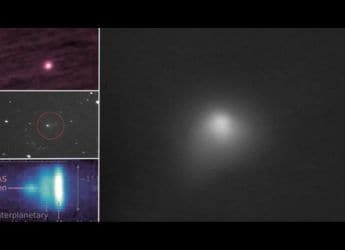- Home
- Science
- Science News
- James Webb Detects Carbon Dioxide–Dominated Coma in Interstellar Object 3I/ATLAS
James Webb Detects Carbon Dioxide–Dominated Coma in Interstellar Object 3I/ATLAS
The James Webb Space Telescope observed 3I/ATLAS, the third interstellar object detected in our solar system.

Photo Credit: NASA
JWST reveals CO₂-rich coma in interstellar object 3I/ATLAS, hinting at alien system origins
The entry of a third known object named 3I/ATLAS into our solar system has been confirmed on July 1, 2025 by the astronomers. On August 6, 2025, The James Webb Space Telescope (JWST) trained its infrared vision and its Near-Infrared Spectrograph instrument (NIRspec) on the interstellar visitor. As the third object ever discovered floating through our solar system, 3I/ATLAS was identified by the ATLAS (Asteroid Terrestrial-impact Last Alert System) survey telescope and is thought to have come from around another star. This observation revealed a coma dominated by carbon dioxide (CO₂), accompanied by unexpectedly low levels of water and carbon monoxide. The unusual composition suggests that 3I/ATLAS possesses either a CO₂-rich interior or an insulating outer layer suppressing water outgassing.
A CO₂-Dominated Coma Unveiled
According to a preprint paper, spectroscopic imaging from JWST's NIRSpec instrument—at a heliocentric distance of about 3.32 AU—has revealed 3I/ATLAS's coma is overwhelmingly rich in CO₂, with a CO₂-to-H₂O mixing ratio of around 8, one of the highest ever recorded in a comet. The mass-loss measurements further underscore the dominance of CO₂: approximately 130 kg/s of CO₂, compared to just 6.6 kg/s of H₂O and 14 kg/s of CO. These results strongly suggest that 3I/ATLAS's nucleus may be intrinsically rich in CO₂, or alternatively, that surface properties—perhaps a highly reflective or insulating crust—limit water sublimation.
Possible origin
The abundance of carbon dioxide coma of 3I/ATLAS is indicative of its intrinsically carbon dioxide rich core and raises compelling questions about its origin and formation environment. One possibility is that it formed near a CO₂ frost line within its parent star's protoplanetary disk, or that long-term exposure to cosmic radiation altered its volatile inventory. Alternatively, an insulating outer layer could be masking water beneath the surface.
Notably, other observations—including water activity detected via OH emissions and ultraviolet imaging, as well as emission lines of cyanide and nickel—point to a diverse and evolving coma composition.
Get your daily dose of tech news, reviews, and insights, in under 80 characters on Gadgets 360 Turbo. Connect with fellow tech lovers on our Forum. Follow us on X, Facebook, WhatsApp, Threads and Google News for instant updates. Catch all the action on our YouTube channel.
- Samsung Galaxy Unpacked 2025
- ChatGPT
- Redmi Note 14 Pro+
- iPhone 16
- Apple Vision Pro
- Oneplus 12
- OnePlus Nord CE 3 Lite 5G
- iPhone 13
- Xiaomi 14 Pro
- Oppo Find N3
- Tecno Spark Go (2023)
- Realme V30
- Best Phones Under 25000
- Samsung Galaxy S24 Series
- Cryptocurrency
- iQoo 12
- Samsung Galaxy S24 Ultra
- Giottus
- Samsung Galaxy Z Flip 5
- Apple 'Scary Fast'
- Housefull 5
- GoPro Hero 12 Black Review
- Invincible Season 2
- JioGlass
- HD Ready TV
- Laptop Under 50000
- Smartwatch Under 10000
- Latest Mobile Phones
- Compare Phones
- Poco F8 Ultra
- Poco F8 Pro
- Huawei Mate 80 RS Master Edition
- Huawei Mate 80 Pro Max
- Huawei Mate 80 Pro
- Huawei Mate 80
- Huawei Mate X7
- Honor 500
- Asus ProArt P16
- MacBook Pro 14-inch (M5, 2025)
- Poco Pad M1
- Poco Pad X1
- Honor Watch X5
- Huawei Watch Ultimate 2
- Acerpure Nitro Z Series 100-inch QLED TV
- Samsung 43 Inch LED Ultra HD (4K) Smart TV (UA43UE81AFULXL)
- Asus ROG Ally
- Nintendo Switch Lite
- Haier 1.6 Ton 5 Star Inverter Split AC (HSU19G-MZAID5BN-INV)
- Haier 1.6 Ton 5 Star Inverter Split AC (HSU19G-MZAIM5BN-INV)












